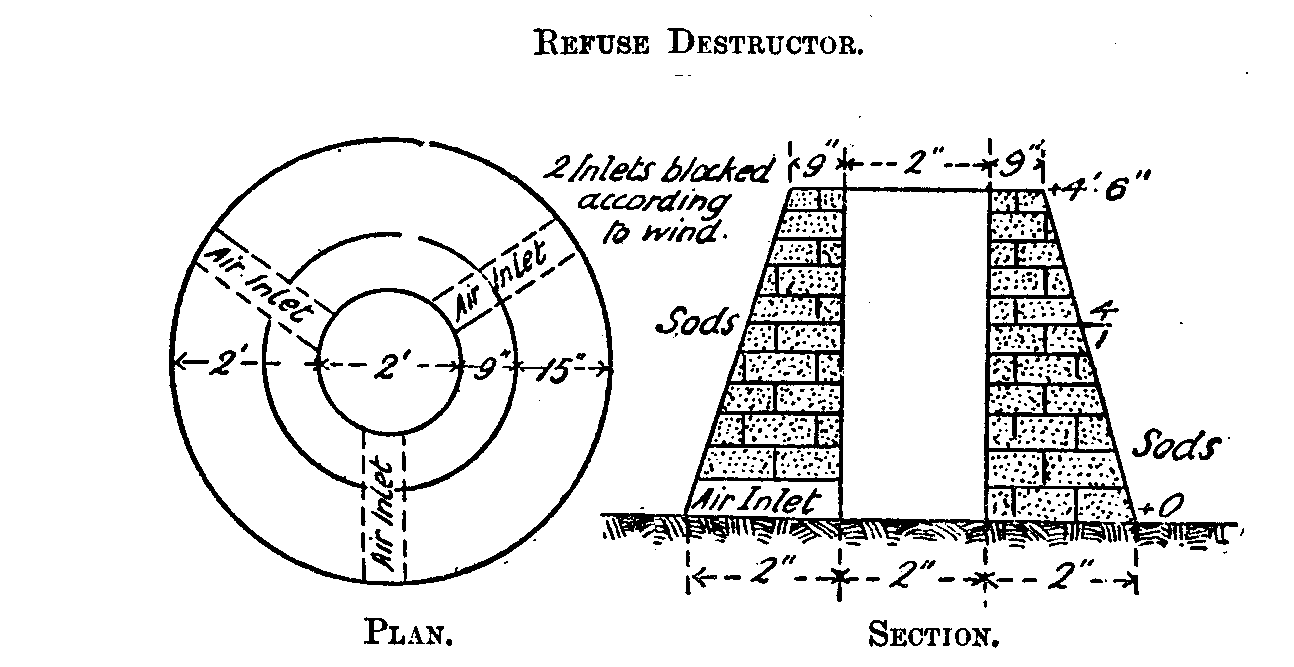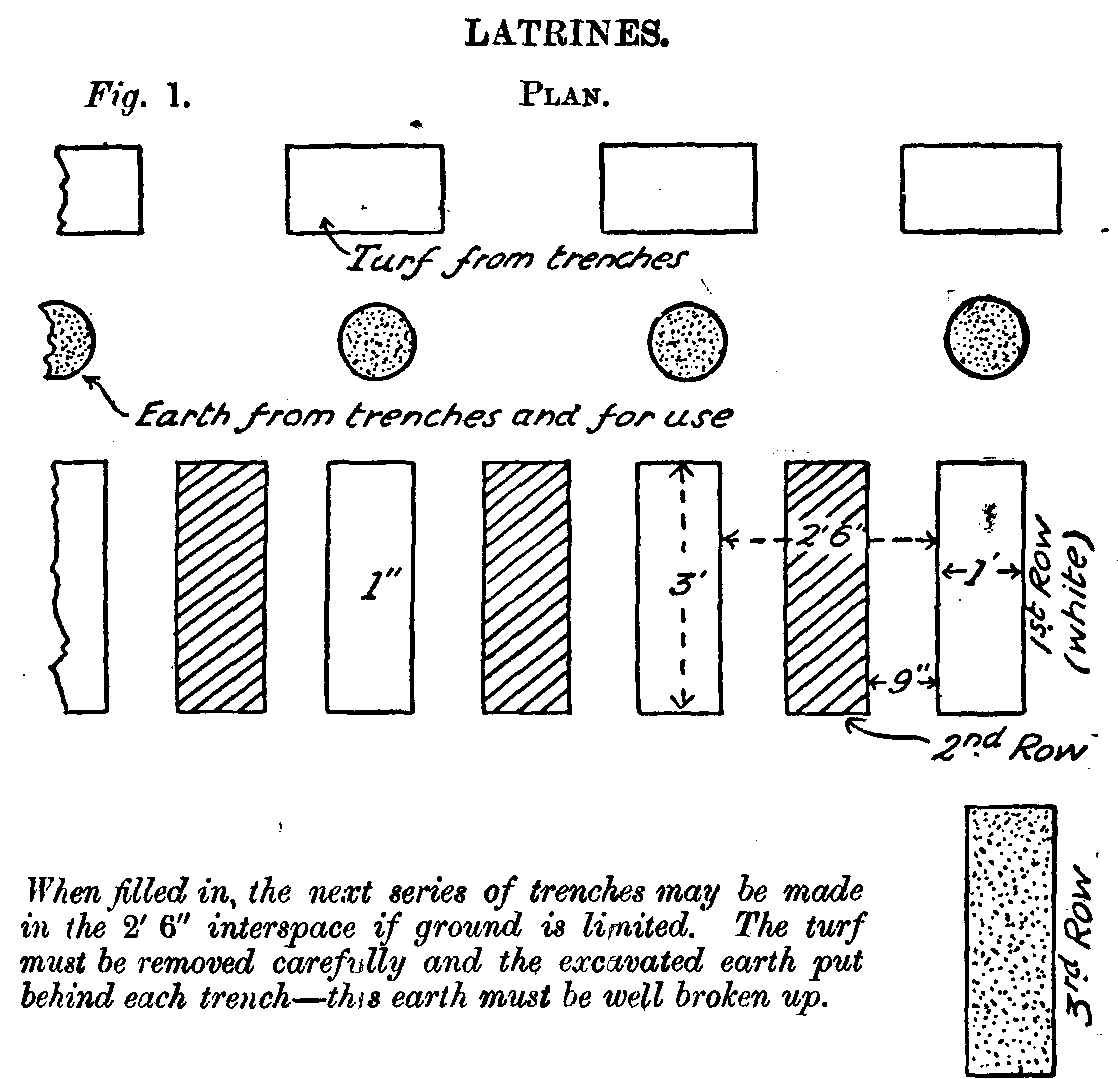
SANITATION OF CAMPS AND BIVOUACS.
1. The importance of prevention of disease on field service cannot be overestimated. Neglect of sanitary measures inevitably results in great loss of life, and disease may assume such proportions as to paralyse the efficiency of a force. It is the duty of both officers and men to comply strictly with orders relating to the preservation of health. To keep himself healthy and fit is a duty that every soldier owes to his country, his comrades, and himself.
2 In all camps the utmost care must be taken to prevent fouling of ground by excreta and refuse. Therefore urinals and latrines should be made immediately on arrival at a camp or bivouac, and should be filled in at the last possible moment.
3. Great attention must be paid to camp kitchens. Kitchen slop water should be disposed of in pits covered with brushwood, straw or any other material that will retain the grease. The brushwood, &c., should then be used as fuel in the kitchen fires. The habit of throwing kitchen water about to allay dust increases instead of diminishing discomfort in camp.
4. Food must be protected from dust and flies. To keep camps free from flies, horse dung, stable litter and other refuse, which form natural breeding places for those insects mast be carefully disposed of.
Refuse of all descriptions should be burnt daily, and what cannot be burnt should be buried. The carcasses of dead animals should be removed from any ground likely to be wanted for camping, disembowelled and the viscera buried deeply. In standing camps the carcasses should be burnt or buried.
5. A drawing of an incinerator for disposal of camp refuse is shown below.

Another effective incinerator consists of a circular, shallow, saucer-like depression, 10 feet in diameter, and not more than 2 feet deep in the centre,
shelving gradually to the level of the ground at its edge. The whole of this hollow is lined with large stones
or broken bricks, and a low wall built up round it, the excavated earth being packed against it to prevent surface
water gaining access, and also to provide a sloping approach for tilting refuse into it. Next, a pyramid of large
stones is built up in the centre of the basin; this pyramid should rise so as to have its top some 2 feet or more
above the level of the rim or encircling wall. The object of the central cairn is to provide a steady draught through
the centre of the burning material. Ordinary dry wood or brushwood must be used to start the fire, and after it
is well burning it can be maintained by steadily adding refuse. The stones soon become intensely hot, and serve
to dispose of liquid and damp stuff with rapidity. This incinerator is eminently adapted for stony or rocky country.
6. To keep tents dry they should be trenched; flies of tents should be rolled up daily, and blankets and kits aired.
7. Cleanliness both of persons and clothing is of great importance. The feet should be washed or wiped at least once daily. The nails, mouth and hair require attention as well as the skin. Underclothing should be washed at least once a week.
8. Latrines, urinals, refuse pits, horse and cattle lines, and slaughtering places must be placed as far as possible from the kitchens, from any source. of water supply, and to leeward if possible. They must never be placed in any gullies which, when it rains, may discharge into the water supply. A sanitary policeman should be placed in charge of each latrines his duty being to see that every man covers up his excreta with earth. Failure to carry out this practice should be punished.
Slaughtering places should not be near horse lines.
9. In camps, short trench latrines should be dug. Each trench should be 3 feet long, 1 foot wide, and 1 foot deep, the interspace between each trench being 21 feet; men should use these trenches straddlewise, and at once cover up their deposit with earth. Five trenches will suffice for 100 men for one day ; they should then he filled in with earth and the turf replaced.
Trenches required for the second day of occupation will be dug in the spaces between the first row of trenches.
The method of preparing the short trench latrine is shown in the figure below.

If the area of ground be limited, the depth of the short trench may be increased to 2 feet; these deeper trenches should last 2 days.
In some cases, deep latrines may be necessary ; they should he constructed to seat 5 per cent. of the troops, 1 yard per man being allowed. This type, of latriue is shown in Plate 8.
The position of all old latrines should be marked with the letter L made with stones, &c.
10. Disinfectants.- For general use, cresol solution and chloride of lime are the most efficacious. To use cresol, mix 1 ½ ounces of cresol solution with 1 gallon of water.
Clothing may be disinfected by being plunged into boiling water, or by being baked in an oven heated from 210o to 250o Fahrenheit.